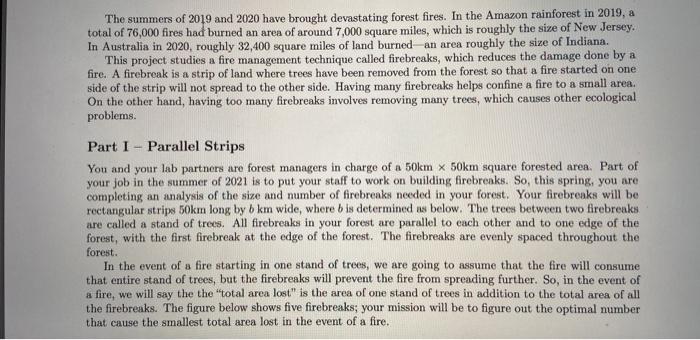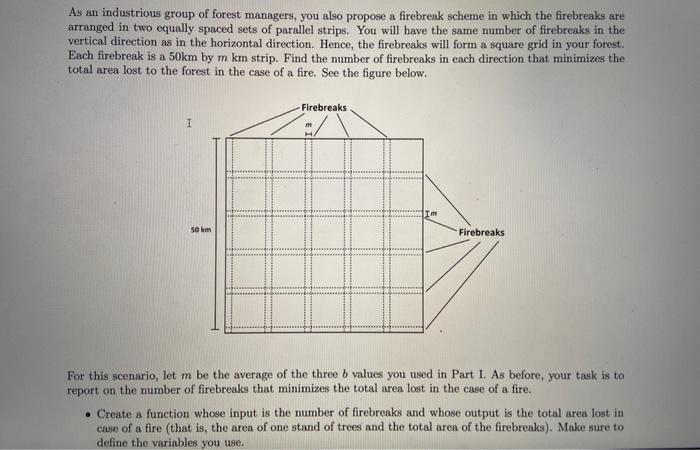Please tell me the function and how you came up with it.
The summers of 2019 and 2020 have brought devastating forest fires. In the Amazon rainforest in 2019, a total of 76,000 fires had burned an area of around 7,000 square miles, which is roughly the size of New Jersey. In Australia in 2020, roughly 32,400 square miles of land burned an area roughly the size of Indiana. This project studies a fire management technique called firebreaks, which reduces the damage done by a fire. A firebreak is a strip of land where trees have been removed from the forest so that a fire started on one side of the strip will not spread to the other side. Having many firebreaks helps confine a fire to a small area. On the other hand, having too many firebreaks involves removing many trees, which causes other ecological problems. Part I - Parallel Strips You and your lab partners are forest managers in charge of a 50km x 50km square forested area. Part of your job in the summer of 2021 is to put your staff to work on building firebreaks. So, this spring, you are completing an analysis of the size and number of firebreaks needed in your forest. Your firebreaks will be rectangular strips Bkm long by bkm wide, where b is determined as below. The trees between two firebreaks are called a stand of trees. All firebreaks in your forest are parallel to each other and to one edge of the forest, with the first firebreak at the edge of the forest. The firebreaks are evenly spaced throughout the forest. In the event of a fire starting in one stand of trees, we are going to assume that the fire will consume that entire stand of trees, but the firebreaks will prevent the fire from spreading further. So, in the event of a fire, we will say the the total area lost" is the area of one stand of trees in addition to the total area of all the firebreaks. The figure below shows five firebreaks; your mission will be to figure out the optimal number that cause the smallest total area lost in the event of a fire. As an industrious group of forest managers, you also propose a firebreak scheme in which the firebreaks are arranged in two equally spaced sets of parallel strips. You will have the same number of firebreaks in the vertical direction as in the horizontal direction. Hence, the firebreaks will form a square grid in your forest. Each firebreak is a 50km by m km strip. Find the number of firebreaks in each direction that minimizes the total area lost to the forest in the case of a fire. See the figure below. Firebreaks I H [m 50 km Firebreaks For this scenario, let m be the average of the three b values you used in Part I. As before, your task is to report on the number of firebreaks that minimizes the total area lost in the case of a fire. Create a function whose input is the number of firebreaks and whose output is the total area lost in case of a fire (that is, the area of one stand of trees and the total area of the firebreaks). Make sure to define the variables you use. The summers of 2019 and 2020 have brought devastating forest fires. In the Amazon rainforest in 2019, a total of 76,000 fires had burned an area of around 7,000 square miles, which is roughly the size of New Jersey. In Australia in 2020, roughly 32,400 square miles of land burned an area roughly the size of Indiana. This project studies a fire management technique called firebreaks, which reduces the damage done by a fire. A firebreak is a strip of land where trees have been removed from the forest so that a fire started on one side of the strip will not spread to the other side. Having many firebreaks helps confine a fire to a small area. On the other hand, having too many firebreaks involves removing many trees, which causes other ecological problems. Part I - Parallel Strips You and your lab partners are forest managers in charge of a 50km x 50km square forested area. Part of your job in the summer of 2021 is to put your staff to work on building firebreaks. So, this spring, you are completing an analysis of the size and number of firebreaks needed in your forest. Your firebreaks will be rectangular strips Bkm long by bkm wide, where b is determined as below. The trees between two firebreaks are called a stand of trees. All firebreaks in your forest are parallel to each other and to one edge of the forest, with the first firebreak at the edge of the forest. The firebreaks are evenly spaced throughout the forest. In the event of a fire starting in one stand of trees, we are going to assume that the fire will consume that entire stand of trees, but the firebreaks will prevent the fire from spreading further. So, in the event of a fire, we will say the the total area lost" is the area of one stand of trees in addition to the total area of all the firebreaks. The figure below shows five firebreaks; your mission will be to figure out the optimal number that cause the smallest total area lost in the event of a fire. As an industrious group of forest managers, you also propose a firebreak scheme in which the firebreaks are arranged in two equally spaced sets of parallel strips. You will have the same number of firebreaks in the vertical direction as in the horizontal direction. Hence, the firebreaks will form a square grid in your forest. Each firebreak is a 50km by m km strip. Find the number of firebreaks in each direction that minimizes the total area lost to the forest in the case of a fire. See the figure below. Firebreaks I H [m 50 km Firebreaks For this scenario, let m be the average of the three b values you used in Part I. As before, your task is to report on the number of firebreaks that minimizes the total area lost in the case of a fire. Create a function whose input is the number of firebreaks and whose output is the total area lost in case of a fire (that is, the area of one stand of trees and the total area of the firebreaks). Make sure to define the variables you use








